We all wish we could conjure up some magical growth for our business. But while quick hacks with 100x results sound enchanting, the reality of marketing success lies in being grounded and effective over the long term.
Growth marketing strategies are more about rigorous experimentation and data analysis than waving a magic wand. They rely on data-driven decisions that provide a holistic approach to the customer journey and ensure your marketing campaign plans deliver long-term sustainable growth.
Let’s run through the basics of growth marketing and I’ll highlight 10 proven strategies you can implement in your business.
What are growth marketing strategies?
Growth marketing strategies are techniques used to increase a company’s revenue, customer base, and market presence. These strategies focus on rapid and sustainable growth through data-driven decision-making, experimentation, and optimization.
Key tactics include SEO, content marketing, social media campaigns, email marketing, referral programs, and product development. These efforts prioritize customer acquisition, retention, and engagement.
Why growth marketing strategies are essential for business growth
Growth marketing isn’t just a fad or a buzzword. It’s a decade-old concept embraced by agile, competitive businesses.
Growth marketing strategies are derived from growth hacking in the sense that they leverage creativity and experimentation to drive results better and faster than traditional marketing efforts.
Rather than sticking to the awareness and acquisition part of the marketing funnel, these strategies extend all the way to retention and referral, maximizing customer lifetime value.
The best part is that a growth marketing strategy is data-driven, allowing you to make informed decisions based on real-time analytics and performance metrics — not on guesses.
Another advantage is that growth marketing focuses on adaptability. Marketing teams that leverage it can pivot quickly in response to market changes and customer feedback. This customer-centric approach improves loyalty and long-term engagement.
In short, you’re more likely to attract new customers but also retain existing ones, leading to sustainable business growth. Sound good? Let’s unpack the magic trick.
The key components of a successful growth marketing strategy
A strong growth marketing strategy is built on several key components that work together to drive sustainable business growth.
Here’s what skilled growth marketers do:
Conduct data analysis
Growth marketing, as I’ve mentioned, isn’t about pulling tricks out of thin air but from real-world data. In that sense, you’re more of a researcher than a magician.
By gaining insights from numbers, you understand customer needs and desires, identify trends, and generate ideas that captivate audiences. This data-driven approach eliminates guesswork and is more likely to result in improved marketing ROI.
Gather and analyze data from various sources such as:
- Website analytics — Get insights into user behavior, page performance, and conversion rates.
- Social media — Understand engagement levels, audience demographics, and content effectiveness.
- CRM — Leverage the wealth of demographics from your customer relationship management system.
- Customer feedback — Uncover qualitative insights into customer satisfaction and areas for improvement from surveys, reviews, and direct client interactions.
- Marketing campaigns — Understand what’s working and what can be improved in your marketing funnel.
Combine these data sources to get a comprehensive view of your target audience and the effectiveness of your marketing efforts.
Map the customer journey
Growth marketing is about optimizing the entire customer journey, so mapping it is an essential step.
Mapping the customer journey involves clearly putting the entire process a customer goes through on paper, from the first time they hear about your brand to post-purchase engagement.
This process helps you pinpoint key touchpoints where customers connect with your brand, uncover gaps in interaction, observe obstacles in the road, and take note of opportunities for improvement.
What does this journey look like? Rishabh Dev, a growth marketing consultant, proposes the following funnel:
- Awareness
- Acquisition
- Activation
- Retention
- Revenue
- Referral
It can be the same for you, or based on your observations, you can include other steps. What’s important is not to stop at the point of sale and remember that growth marketing is also about loyalty and long-term engagement.
Before moving to the next step, make sure you understand each stage of the customer journey and can visualize the experience as a whole — complete with roadblocks and construction sites.
Run experiments and A/B tests
Experimentation is another cornerstone of growth marketing.
By running experiments and A/B tests, growth marketers discover new strategies and optimize existing ones. These tests involve comparing two versions of a webpage, email, or ad to see which performs better.
For example, an e-commerce company might test two different versions of a product page — one with a video demonstration and one with customer reviews. The version that leads to higher sales is the winner and can inform future design and content choices.
This method provides concrete data on what resonates with the audience, allowing you to refine your approach based on evidence rather than assumptions.
Experimentation should be continuous, not just a one-time event. Iterate on what works best and keep looking for opportunities to improve conversion rates by tweaking different elements and measuring results.
Collaborate with other teams
Growth marketing isn’t a solo act.
Bring together marketing, sales, product, and customer support teams to mix different perspectives and strengths in the hat. You won’t pull out a rabbit, but more cohesive and creative strategies.
When marketing aligns campaigns with sales goals, product teams build features based on customer needs identified by support, and customer feedback informs both marketing and product development, everyone benefits.
Content collaboration tools can streamline this process, ensuring everyone is on the same page and can provide quick and timely feedback and approvals.
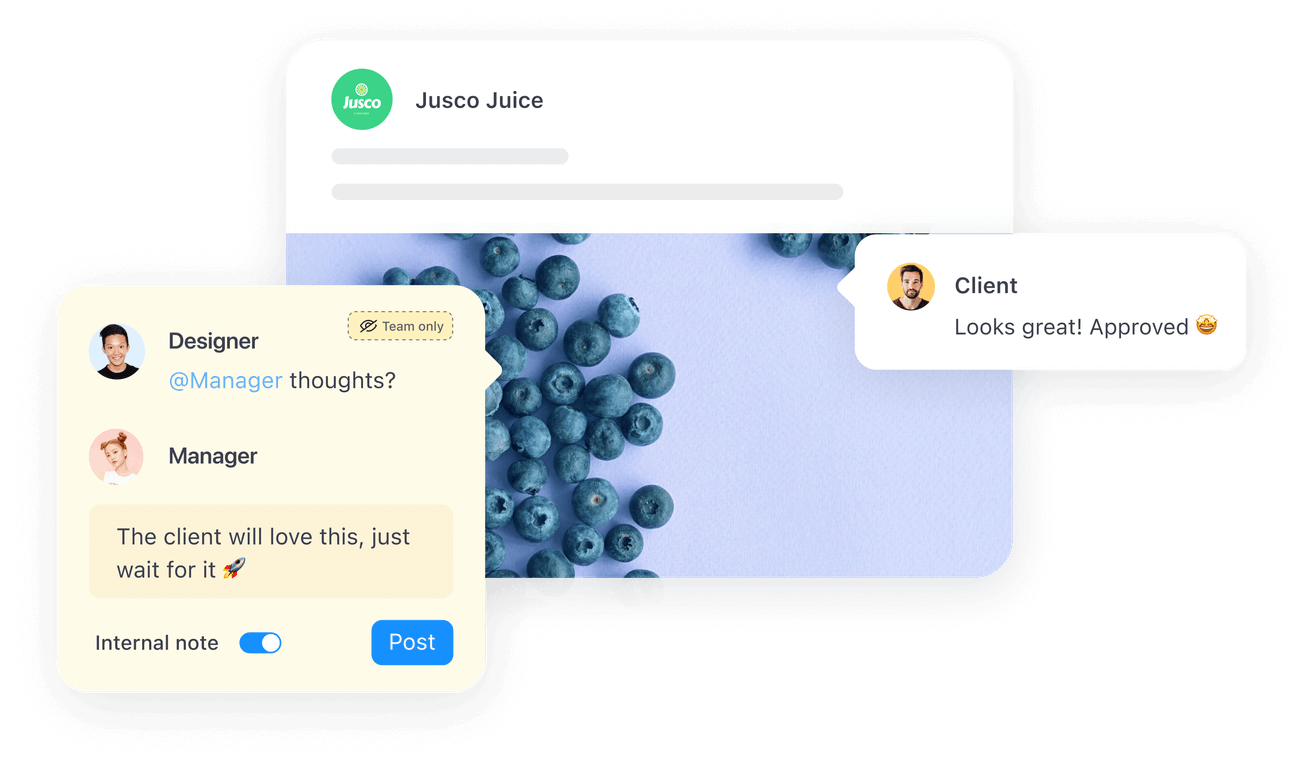

Internal comments in Planable
These tools help eliminate bottlenecks and roadblocks, ensuring that growth is not stifled by bureaucracy.
Optimize and refine over time
“This is quick-acting, but this is long-lasting. When do I need to feel good? Now or later?” asks Jerry Seinfeld in one of the episodes of his famous ’90s sitcom. Tough call.
Growth marketing combines the two. On the one hand, you get quick optimizations that boost results. On the other hand, it’s a continuous process that adds up and results in long-term improvements.
As Rick Ramos, Fractional CMO at Transform Your Marketing, puts it:
“Identifying growth opportunities isn’t about trying everything. It’s about having a cohesive plan that aligns your brand, marketing strategy, and growth tactics. This involves continuous analysis of customer data, market trends, and competitor activities, coupled with a willingness to experiment and pivot based on results.”
By consistently evaluating the effectiveness of campaigns and making data-driven adjustments, you can ensure sustained growth and adaptability while also seeing rapid improvements.
Use technology and tools
Technology and tools help you accelerate your marketing efforts.
Using marketing automation, analytics, and collaboration platforms can streamline processes, improve efficiency, and provide deeper insights into customer behavior in real-time.
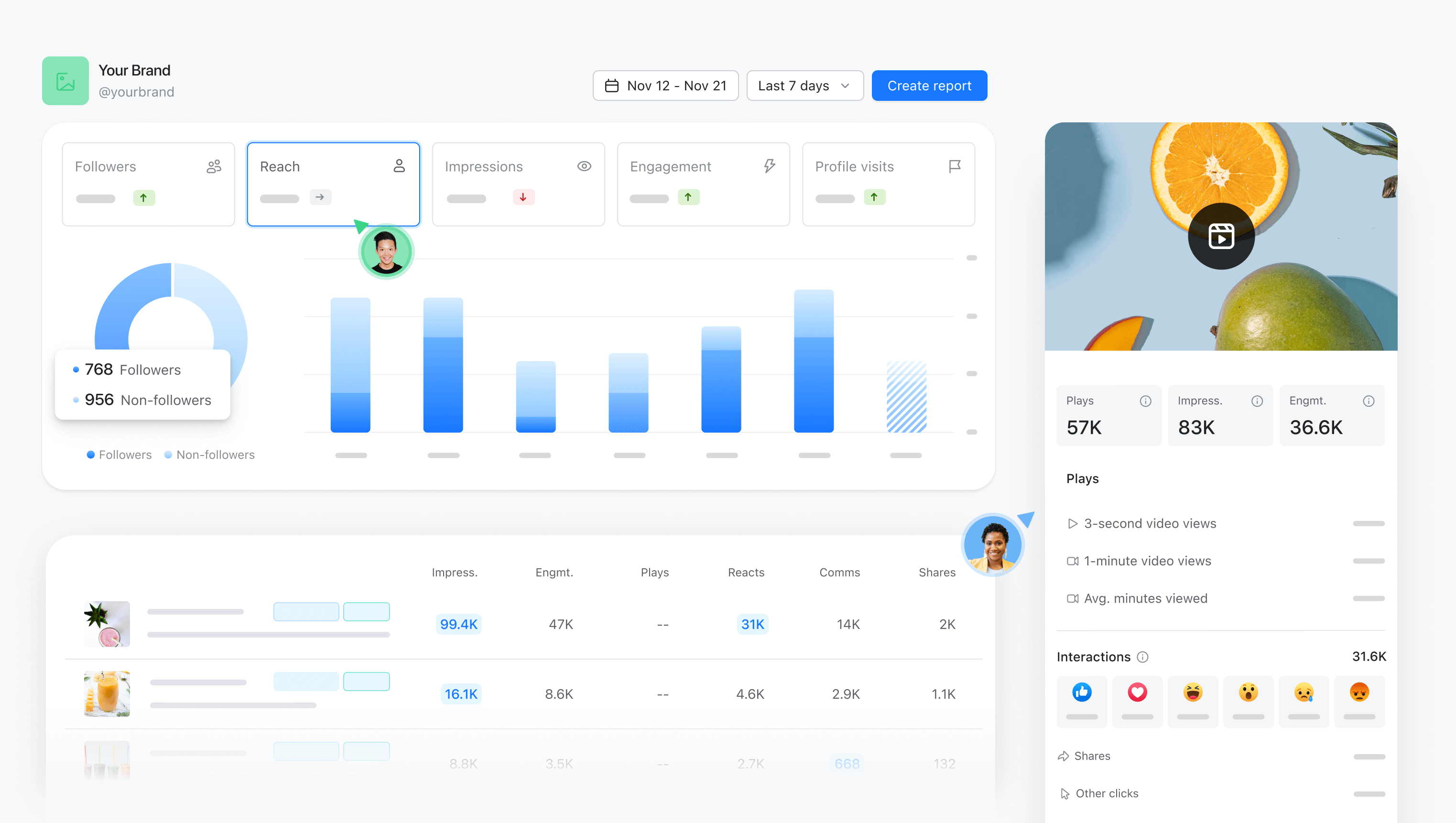

Social media analytics dashboard in Planable
For example, a marketing automation tool can streamline data gathering and audience segmentation, while AI content creation tools can help you generate personalized content at scale, ensuring consistent and targeted messaging.
Not only do you become more efficient by leveraging these tools, but you also get more time and space to be creative and come up with unique, innovative ideas.
Iterate based on customer feedback
You never run out of ideas when you pay attention to your clients. Customer insights provide valuable information on what’s working well and what needs improvement.
I asked George Coudounaris, Founder of The B2B Playbook, about how he uses customer feedback to guide his approach to growth:
“To find new growth opportunities, I first define who my best customers are using 80/20 analysis, and conduct in-depth customer interviews with them. Your best customers will guide you on where you need to go next. Perhaps you find out from your interviews that there’s a certain conference or event that they all attend to discover products like yours – so then events can become a key part of your strategy. Perhaps there are subject matter experts that they trust for new knowledge in their industry, and they could form the basis of a collaboration or ‘influencer’ campaign for your business. Testing and learning are important – but get the ideas for your tests from your customers directly.”
Regularly engaging with customers and incorporating their feedback helps you make informed adjustments to your marketing strategy. It’s the only way to remain relevant and connected to people’s evolving expectations.
10 proven growth marketing strategies
Designed for lasting impact, the following strategies are tried and tested and will propel you ahead of the competition. Bonus: experts chip in with valuable advice.
1. Optimize your marketing funnel
Optimizing your marketing funnel for the right target audience is essential for maximizing conversion rates and driving growth.
Let’s take the funnel mentioned earlier in the article and see what strategies you can use for each:
- Awareness. Get people to know your brand and make a great first impression by publishing relevant content on your website and on social media.
- Acquisition. Attract potential customers through targeted advertising, SEO, and content marketing.
- Activation. Engage new users with nurturing email sequences, product demos, and personalized content.
- Retention. Keep customers coming back with loyalty programs, regular updates, and exceptional customer service.
- Revenue. Maximize revenue through upselling, cross-selling, and personalized offers.
- Referral. Encourage satisfied customers to refer others by offering incentives and creating shareable content.
Remember that personalization is key throughout. During my conversation with George, he talked from experience about how niching down helped The B2B Playbook to optimize their approach:
“Niching down is one of the hardest decisions a business will make, but you will be so grateful once you do it. To get traction as a B2B Marketing resource and stand out from the crowd, we had to define who our podcast and our demand generation course were best suited to. That meant calling out exactly who it was for (B2B Marketing Managers, CMOs, Heads of Marketing/Growth, Demand Gen Marketers), and speaking very specifically to their pain points. The results? We gained followers of our podcast much faster (now 20k+), The B2B Playbook is consistently referred to as a ‘go-to resource’ for demand generation, and our conversion rates for our Demand Generation Program are significantly higher.”
By clearly defining your target audience and addressing their specific pain points, you can more effectively optimize each stage of the funnel.
2. Implement A/B testing
A/B testing is a sure way to test performance and can be applied to emails, landing pages, ads, and other marketing materials. By systematically testing different versions, growth marketers find the most effective strategies for driving conversions.
To conduct an A/B test:
- Select an element to test, such as a headline, image, or call-to-action.
- Develop two or more versions of the selected element.
- Split your audience randomly and expose each group to a different version.
- Measure each version’s performance based on key metrics such as click-through and conversion rates or engagement levels.
- Use the insights gained from the test to optimize your marketing strategy.
I asked Rick how heavily he emphasizes testing in his work:
“I love to test copy and A/B test my landing pages and websites using tools like VWO. This is step one with all my work in developing funnels.”
You, too, can leverage specialized platforms to easily include A/B testing in your marketing routine.
3. Trigger campaigns with email marketing automation
Email marketing is, in general, one of the most effective tools in your toolkit. Add automation on top, and it becomes a powerful method for nurturing leads and retaining customers.
Here are a few examples of automated workflows that help you deliver timely and relevant messages to your audience with guaranteed engagement:
- Welcome series have some of the highest engagement rates because you have people’s full attention. Greet new subscribers or clients with a series of emails that introduce your brand and offerings. Be authentic, use storytelling, and take this opportunity to upsell or cross-sell.
- Re-engagement campaigns can help you reconnect with inactive customers who were once loyal fans. To tickle their interest once more, be direct, personalize messages, and offer special discounts or promotions on their favorite products.
- Newsletters with personalized recommendations are a sure way to get people’s attention. Send tailored product suggestions based on customers’ past purchases and browsing behavior to see those conversation rates rise.
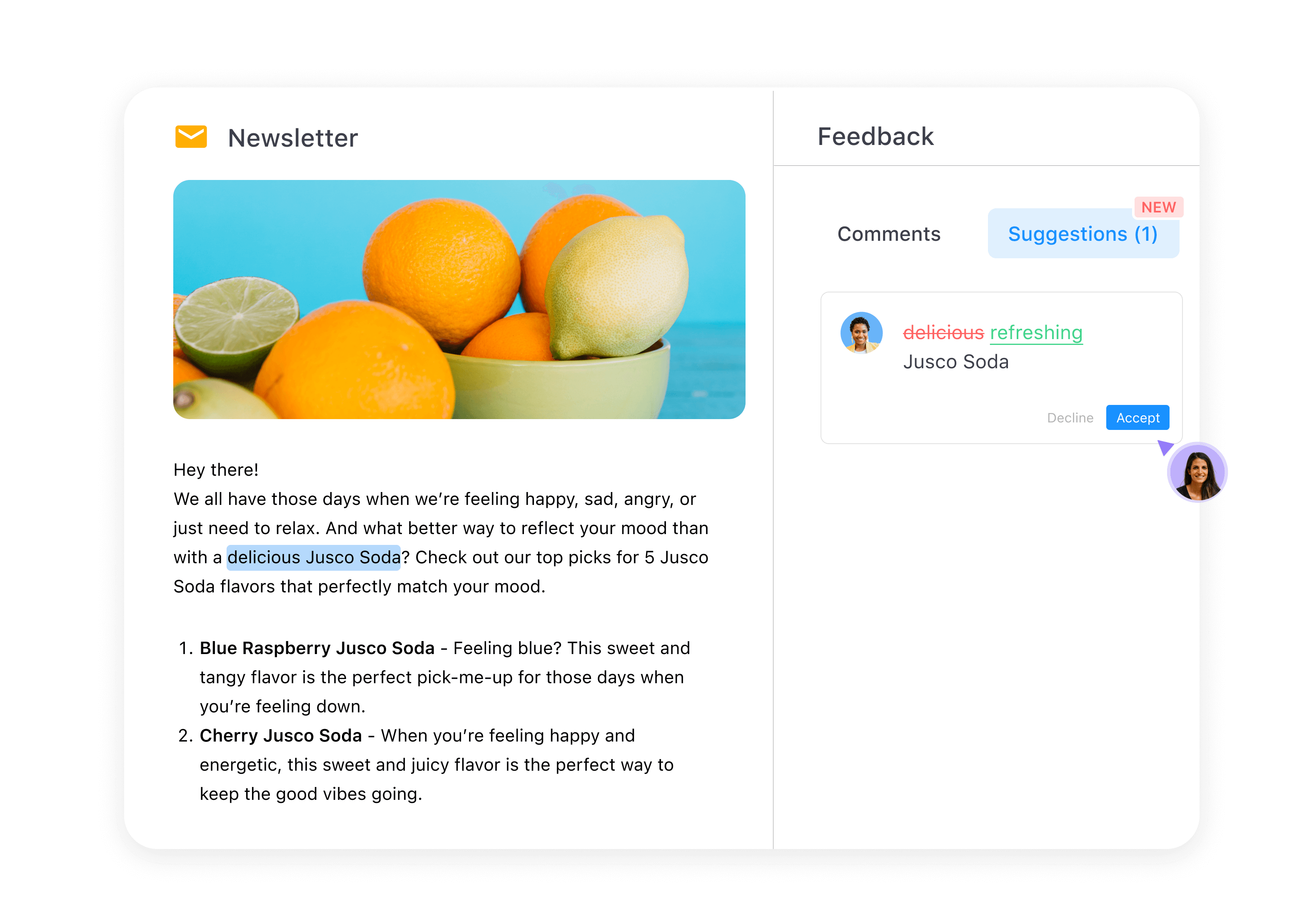

Collaboration on a newsletter in Planable
But when it comes to running any marketing campaigns, Rick was keen to underscore the importance of a balanced, long-term approach:
“I am a huge believer in creating a strong brand strategy and not trying hacks to make short-term gains. I’ve seen this inside many organizations that over-index to promotions and short-term tactics to hit goals. For example, sending out too many emails in a quarter might help you hit your numbers but at the expense of future email delivery and reputation. I think most marketers know the balance but it’s about managing expectations for all stakeholders in a company.”
Use email marketing automation wisely, leveraging segmentation and personalization, to keep your subscribers close, and clients closer.
4. Use social media for growth
Everyone uses social media these days. But how many brands are constantly improving their social media ROI?
Here are a few growth marketing strategies that leverage social media platforms not just for vanity but for results:
It’s easier said than done but not impossible when you follow the steps I’ve outlined. When you know your audience and gather data, you can create and share informative, entertaining, and visually appealing content that resonates with clients.
- Leverage paid social media campaigns
Run targeted ad campaigns to reach potential customers based on their interests, demographics, and online behavior. A/B test to constantly optimize results.
Platforms like Planable integrate AI capabilities to help you optimize content creation, automate post scheduling, and personalize interactions. These tools are a great way to scale your social media strategy with little effort, allowing you to still try innovative ideas.
- Experiment with new platforms and formats
You think your brand won’t make an impact on TikTok (or other emerging channels)? Why not try it and see instead of making assumptions? Adjust existing content to other formats and give yourself a few weeks or months to gather data. You might be surprised by the results and discover new opportunities for growth.
Destiny Flaherty, SEO Manager at Princess Polly, emphasizes the importance of understanding user trends and meeting your audience where they are:
“Staying on top of user trends is key. Meet your audience where they already are, and utilize channels they associate with. For example, if your demographic is B2C and Gen-Z, TikTok and Pinterest are great growth channels. If your audience is B2B and professionals, LinkedIn might be a better choice. Use data to inform your strategy, test to pulse check your decision, and pivot if necessary!”
Tools like Planable can streamline your social media calendar by helping you manage and schedule posts across multiple platforms, ensuring consistent and timely content delivery.
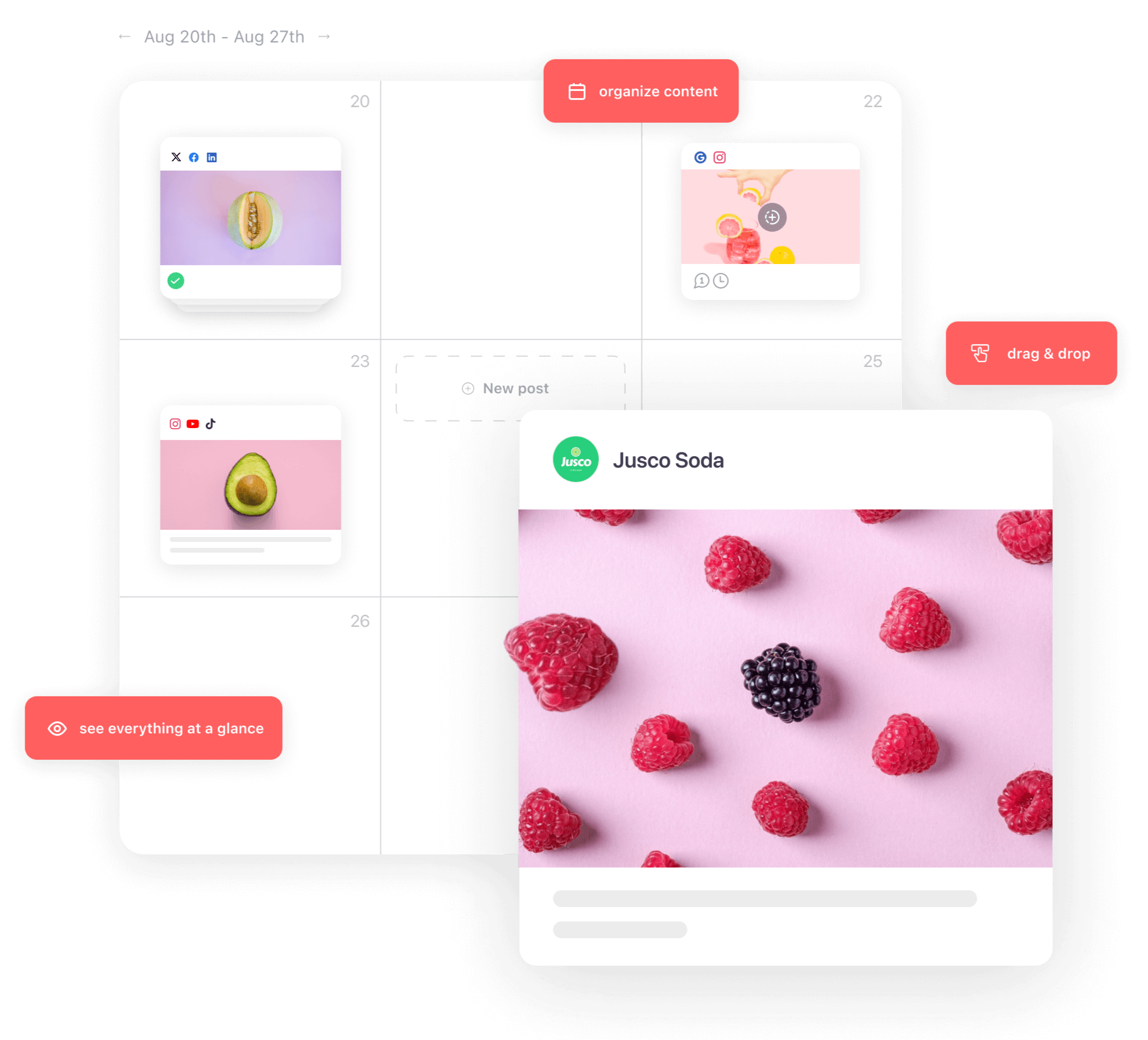

Drag-and-drop content calendar in Planable
5. Build trust with user-generated content
Customer stories are a goldmine for any business. User-generated content (UGC) is a powerful tool for building trust and likability and generating a buzz.
When customers share their experiences using your products and interacting with your brand, it’s the best kind of endorsement. This genuine content is more credible and authentic than brand-created content and helps attract new followers and convince prospects to buy.
Moreover, UGC helps foster a strong community around your brand.
To encourage UGC, use branded hashtags and run contests and challenges. Share people’s content on your social media and in newsletters and feature it on the website to increase engagement and build stronger connections.
6. Expand your reach with influencer partnerships
Partnering with the right influencers can significantly expand your reach and quickly build credibility with wider audiences.
Influencers have established communities that trust them, making their endorsements a powerful tool for boosting brand credibility and customer acquisition.
In my experience, the best partnerships involve close collaboration on content. Using a shared platform or workspace makes a big difference when it comes to preparing and proposing posts, implementing feedback, and getting approval from both sides.
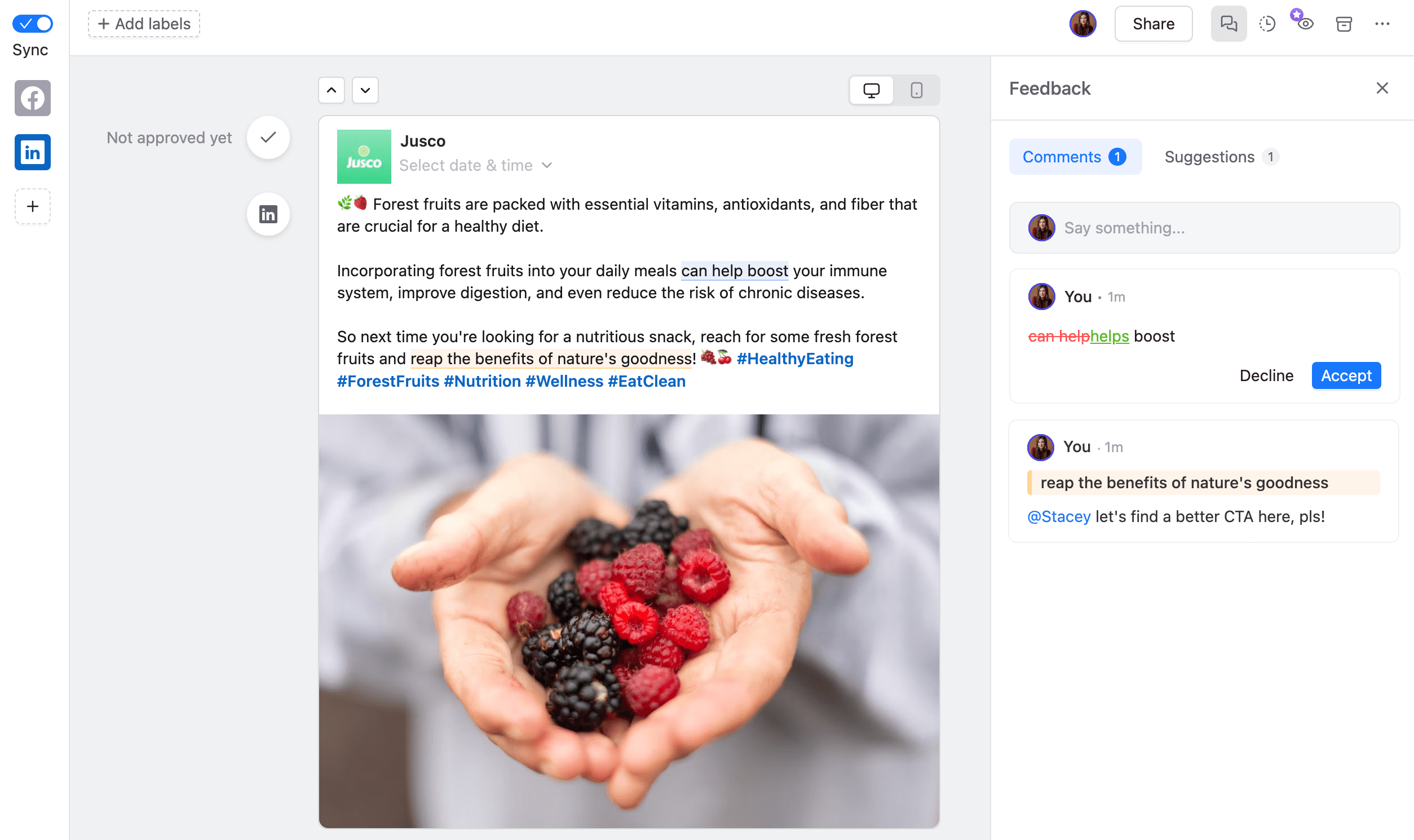

Collaboration on a LinkedIn post in Planable
To maximize the impact of influencer marketing, choose influencers who are relevant to your niche and whose followers align with your target audience. Also, don’t necessarily go for the biggest names — as everyone else does. Instead, focus on micro and nano influencers, too. They may have a smaller following, but their community is likely even more present and engaged, so you might be able to get better results.
Create mutually beneficial partnerships to ensure influencers are motivated. Offer financial compensation, free products, or exclusive experiences so that the output feels genuine and aligned with the influencer’s brand and audience.
7. Focus on customer success and advocacy
Customer retention is a must for sustainable growth. Retaining existing customers is usually more cost-effective and profitable than acquiring new ones.
Personalized communication, loyalty programs, and exceptional customer service are essential for retaining customers. When customers feel valued, understood, and appreciated, they are more likely to stay engaged, keep buying, and bring friends along for the ride.
Pay attention to all the customer touchpoints, gather data and feedback, and improve every interaction. Train your team to provide excellent customer service and prioritize satisfaction.
Happy customers become your best brand advocates. Encourage them to write reviews and send feedback, and incentivize them to recommend you to peers through discounts, loyalty points, and special offers.
Activating customer advocacy not only expands your reach but also strengthens your brand reputation.
8. Implement referral programs
How about getting the customers to do the selling for you? When people love what you do, they naturally want to share it. A referral program gives them an extra incentive to do so and encourages action. It’s word-of-mouth marketing on steroids.
Here’s how to make it work:
Give your customers something valuable. Significant discounts, freebies, or exclusive perks can motivate them to tell their friends about you.
- Make it easy to share and participate
Put your referral program front and center on your website, in emails, and on social media. Clearly explain how to participate and get the rewards.
As with everything in growth marketing, your referral program needs constant improvement too. Use analytics tools to monitor key metrics, such as the number of referrals made, conversion rates, and the overall return on investment. Tweak and improve over time.
9. Attract and engage with content marketing
Content marketing is all about attracting and engaging your ideal customers — at their own pace and in their own space. In other words, you need to be patient, but, when done right, you gradually get more online visibility, build trust, and boost organic traffic.
Remember that a growth marketing strategy is not as much about quick wins as it’s about sustainable results.
To leverage the power of content marketing, use blogging tools to optimize content for search engines. Keep your audience coming back for more by consistently optimizing your blog content strategy to deliver high-quality posts that answer burning questions.
Over time, your content will establish you as an industry leader. This means more customers, stronger relationships, and steady growth.
10. Optimize your SEO strategy
There’s no doubt about it: SEO is crucial for online success. Despite some changes in search behavior, with people turning to AI tools such as ChatGPT or social media platforms to research topics, search engines are still among the main pillars for organic traffic and product discovery.
Focus on keyword research, on-page optimization, and building quality backlinks. By optimizing your website, you can boost visibility and attract more visitors.
Regularly check your SEO health to stay ahead of the competition. As Leigh McKenzie, Digital Strategy Expert & Community Advocate at Traffic Think Tank, wisely notes:
“Nothing is permanent. It’s a tough pill to swallow as a growth marketing and SEO specialist that your work is never really done, and that curveballs and advancements in the industry are always around the corner. You have to recognize when you’ve accomplished a bigger project or achieved a sizeable goal, but that energy can’t stop there. It’s all momentum for the next set of tasks.”
This underscores the importance of continuous effort and adaptation in your SEO workflow. Even after achieving significant milestones, it’s essential to keep refining your strategy. Remember that top search engine links get the overwhelming majority of clicks, so it’s worth the effort.
Tips to implement successful growth marketing strategies
We’ve covered a lot of ground, and you’re ready to put these strategies into action.
Here are a few short and sweet tips to keep in mind as you get started:
- Teamwork makes growth work. Get everyone on the same page. Marketing, sales, product, and support – you’re all in this together.
- Data is key. Keep a close eye on what’s working and what’s not. Use the numbers to guide your next moves.
- Tools supercharge your strategy. There are amazing tools out there, from AI to content collaboration and campaign management software, to help you ease your workload and streamline collaboration.
- Automate the boring stuff. Let technology handle the repetitive tasks so you can focus on the creative and strategic side of things.
Planable is a great tool for all the above. It brings your marketing team together, allows you to automate social media management, streamlines content approvals, and ensures that your SEO, PR, and other content efforts are aligned and focused on customers.
Implement effective growth marketing strategies for long-term success
By putting data to work, bringing your team together, and constantly trying new things, you can build a business that keeps growing. Start experimenting and improving, and don’t get discouraged by bumps in the road. You have plenty of ideas and the right tools at your disposal to overcome challenges, move toward big wins, and join the ranks of successful growth marketers.
While you’re testing something new, why not try Planable to support your content creation and collaboration efforts? You get 50 free posts when you sign up!

